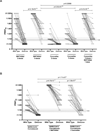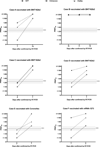Neutralizing antibodies against the SARS-CoV-2 Omicron variant BA.1 following homologous and heterologous CoronaVac or BNT162b2 vaccination
- PMID: 35051989
- PMCID: PMC8940714
- DOI: 10.1038/s41591-022-01704-7
Neutralizing antibodies against the SARS-CoV-2 Omicron variant BA.1 following homologous and heterologous CoronaVac or BNT162b2 vaccination
Abstract
The Omicron variant is rapidly becoming the dominant SARS-CoV-2 virus circulating globally. It is important to define reductions in virus neutralizing activity in the serum of convalescent or vaccinated individuals to understand potential loss of protection against infection by Omicron. We previously established that a 50% plaque reduction neutralization antibody titer (PRNT50) ≥25.6 in our live virus assay corresponded to the threshold for 50% protection from infection against wild-type (WT) SARS-CoV-2. Here we show markedly reduced serum antibody titers against the Omicron variant (geometric mean titer (GMT) < 10) compared to WT virus 3-5 weeks after two doses of BNT162b2 (GMT = 218.8) or CoronaVac vaccine (GMT = 32.5). A BNT162b2 booster dose elicited Omicron PRNT50 titers ≥25.6 in 88% of individuals (22 of 25) who previously received 2 doses of BNT162b2 and 80% of individuals (24 of 30) who previously received CoronaVac. However, few (3%) previously infected individuals (1 of 30) or those vaccinated with three doses of CoronaVac (1 of 30) met this threshold. Our findings suggest that countries primarily using CoronaVac vaccines should consider messenger RNA vaccine boosters in response to the spread of Omicron. Studies evaluating the effectiveness of different vaccines against the Omicron variant are urgently needed.
© 2022. The Author(s), under exclusive licence to Springer Nature America, Inc.
Conflict of interest statement
Figures



Update of
-
Neutralizing antibody titres to SARS-CoV-2 Omicron variant and wild-type virus in those with past infection or vaccinated or boosted with mRNA BNT162b2 or inactivated CoronaVac vaccines.Res Sq [Preprint]. 2022 Jan 5:rs.3.rs-1207071. doi: 10.21203/rs.3.rs-1207071/v1. Res Sq. 2022. Update in: Nat Med. 2022 Mar;28(3):486-489. doi: 10.1038/s41591-022-01704-7. PMID: 35018372 Free PMC article. Updated. Preprint.
References
-
- Viana R, et al. 2021. https://krisp.org.za/manuscripts/ZHTOWa-MEDRXIV-2021-268028v1-deOliveira...
-
- World Health Organization. 2021. https://www.who.int/news/item/26-11-2021-classification-of-omicron-(b.1....
-
- Khoury DS, et al. Nat Med. 27:1205–1211 (2021). - PubMed
Publication types
MeSH terms
Substances
Supplementary concepts
Grants and funding
- N_HKU737/18/National Natural Science Foundation of China (National Science Foundation of China)
- COVID1903003 and COVID190126/Food and Health Bureau (Food and Health Bureau of the Government of the Hong Kong Special Administrative Region)
- U01 AI151810/AI/NIAID NIH HHS/United States
- T11-705/21-N/Research Grants Council, University Grants Committee (RGC, UGC)
- COVID1903003 and COVID190126/Food and Health Bureau of the Government of the Hong Kong Special Administrative Region | Health and Medical Research Fund (HMRF)
LinkOut - more resources
Full Text Sources
Medical
Miscellaneous

